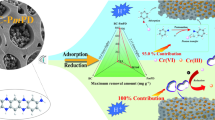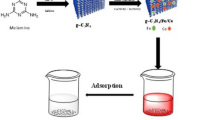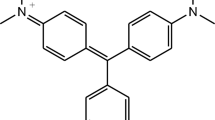Abstract
The environment and human health are in danger due to the long-term enrichment and buildup of organic pesticides, dyes, and harmful microbes in wastewater. The development of functional materials that are efficient for treating wastewater remains a significant problem. Eco-friendly hexagonal spindle-shaped Fe-MOFs (Hs-FeMOFs) were created in this study under the influence of cationic copolymer (PMSt). The mechanism of crystal growth and development of its unique morphology were described after looking into impact factors for the ideal circumstances and being characterized by XRD, TEM, XPS, and other techniques. It revealed that Hs-FeMOFs possess an enormous supply of adsorption active sites, a strong electropositivity, and the nanometer tip. Then, typical organic pollutants, such as herbicides and mixed dyes, as well as biological pollutants bacteria, were chosen to assess its efficacy in wastewater treatment. It was discovered that the pendimethalin could be quickly removed in wastewater and the removal rate reached 100% within 10 min. In separation of mixed dyes, the retention rate of malachite green (MG) reached 92.3% in 5 min and with a minimum inhibitory concentration of 0.8 mg/mL and demonstrated strong activity due to the presence of cationic copolymers. In actual water matrix, Hs-FeMOF could also play excellent adsorption and antibacterial activity. In summary, a novel, environmentally friendly MOF material with good activity was successfully created by cationic copolymer induction. It offers a fresh approach to develop functional materials in wastewater treatment.













Similar content being viewed by others
Data availability
All data generated or analyzed during this study are included in this published article [and its supplementary information files].
References
Cao P, Bai X, He YF, Song PF, Wang RM, Huang JC (2022) Nano-assemblies of phosphonium-functionalized diblock copolymers with fabulous antibacterial properties and relationships of structure-activity. J Mater Chem B 10:9202–9215. https://doi.org/10.1039/d2tb01778d
Bavykina A, Kolobov N, IlS K, Bau JA, Ramirez A, Gascon J (2020) Metal-Organic frameworks in heterogeneous catalysis: recent progress, new trends, and future perspectives. Chem Rev 120:8468–8535. https://doi.org/10.1021/acs.chemrev.9b00685
Bruckmann FS, Rossato Viana A, Tonel MZ, Fagan SB, Garcia WJDS, Oliveira AHD, Dorneles LS, Mortari SR, Da Silva WL, Da Silva IZ et al (2022) Influence of magnetite incorporation into chitosan on the adsorption of the methotrexate and in vitro cytotoxicity. Environ Sci Pollut Res 29:1–22. https://doi.org/10.1007/s11356-022-20786-x
Gao D, Zhang YP, Yan HY, Li BZ, He YF, Song PF, Wang RM (2021) Construction of UiO-66@MoS2 flower-like hybrids through electrostatically induced self-assembly with enhanced photodegradation activity towards lomefloxacin. Sep Purif Technol 265:118486. https://doi.org/10.1016/j.seppur.2021.118486
Gao MW, Li B, Liu J, Hu YN, Cheng HF (2023) Adsorption behavior and mechanism of p-arsanilic acid on a Fe-based metal-organic framework. J Colloid Interf Sci 629:616–627. https://doi.org/10.1016/j.jcis.2022.08.133
Guillerm V, Kim D, Eubank JF, Luebke R, Liu X, Adil K, Lah MS, and Eddaoudi M (2014) A supermolecular building approach for the design and construction of metal-organic frameworks. Chem Soc Rev 436141–6172. https://doi.org/10.1039/C4CS00135D
Guo H, Chen P, Tian S, Ma Y, Li Q, Wen C, Yang J, Zhang L (2020) Amphiphilic marine antifouling coatings based on a hydrophilic polyvinylpyrrolidone and hydrophobic fluorine-silicon-containing block copolymer. Langmuir 36:14573–14581. https://doi.org/10.1021/acs.langmuir.0c02329
Guo T, Lei Y, Hu X, Yang G, Liang J, Huang Q, Li XC, Liu MY, Zhang XY, Wei Y (2022) Hydrothermal synthesis of MXene-MoS2 composites for highly efficient removal of pesticides. Appl Surf Sci 588:152597. https://doi.org/10.1016/j.apsusc.2022.152597
Hajipour MJ, Fromm KM, Ashkarran AA, de Aberasturi DJ, de Larramendi IR, Rojo T, Serpooshan V, Parak WJ, Mahmoudi M (2012) Antibacterial properties of nanoparticles. Trends in Biotechnol 30:499–511. https://doi.org/10.1016/j.tibtech.2012.06.004
Hosono N, Mochizuki S, Hayashi Y, Uemura T (2020) Unimolecularly thick monosheets of vinyl polymers fabricated in metal-organic frameworks. Nat Commun 11:3573. https://doi.org/10.1038/s41467-020-17392-1
Hu N, Chen C, Tan J, Wang WJ, Wang C, Fan HQ, Wang JP, Müller-Buschbaum P, Zhong Q (2020) Enhanced adsorption of methylene blue triggered by the phase transition of thermoresponsive polymers in hybrid interpenetrating polymer network hydrogels, ACS Appl. Polym Mater 2:3674–3684. https://doi.org/10.1021/acsapm.0c00661
Jia WW, Fan QR, Zhang J, Zhu K, Gai S, Yin YY, Yang YL (2022) Smart MOF-on-MOF hydrogel as a simple rod-shapedcor e for visual detection and effective removal of pesticides. Small 18:2201510. https://doi.org/10.1002/smll.202201510
Li XH, Guo WL, Liu ZH, Wang RQ, Liu H (2016) Fe-based MOFs for efficient adsorptionand degradation of acid orange 7 in aqueous solution via persulfate activation. Appl Surf Sci 369:130–136. https://doi.org/10.1016/j.apsusc.2016.02.037
Li YB, Sallach JB, Zhang W, Boyd SA, Li H (2022) Characterization of plant accumulation of pharmaceuticals from soils with their concentration in soil pore water. Environ Sci Technol 56:9346–9355. https://doi.org/10.1021/acs.est.2c00303
Li ZC, Liu XM, Jin W, Hu QS, Zhao YP (2019) Adsorption behavior of arsenicals on MIL-101(Fe): the role of arsenic chemical structures. J Colloid Interface Sci 554:692–704. https://doi.org/10.1016/j.jcis.2019.07.046
Liu JH, Wu D, Zhu N, Wu YN, Li GL (2021) Antibacterial mechanisms and applications of metal-organic frameworks and their derived nanomaterials, Trends Food Sci. Tech 109:413–434. https://doi.org/10.1016/j.tifs.2021.01.012
Lu LL, Wu BY, Shi W, Chen P (2019) Metal-organic framework-derived heterojunctions as nanocatalysts for photocatalytic hydrogen production. Inorg Chem Front 6:3456–3467. https://doi.org/10.1039/C9QI00964G
Ma SH, Yan CY, Cai MR, Yang J, Wang XL, Zhou F, Liu WM (2018) Continuous surface polymerization via Fe(II)-mediated redox reaction for thick hydrogel coatings on versatile substrates. Adv Mater 30:1803371. https://doi.org/10.1002/adma.201803371
Ma Y, Zhang Z, Nitin N, Sun G (2020) Integration of photo-induced biocidal and hydrophilic antifouling functions on nanofibrous membranes with demonstrate reduction of biofilm formation. J Colloid Interface Sci 578:779–787. https://doi.org/10.1016/j.jcis.2020.06.037
Mauro N, Fiorica C, Giuffr M, Calà C, Maida CM, Giammona G (2020) A self-sterilizing fluorescent nanocomposite as versatile material with broadspectrum antibiofilm features. Mater Sci Eng C 117:111308. https://doi.org/10.1016/j.msec.2020.111308
Mostafavi MM, Movahedi F (2018) Fe3O4/MIL-101(Fe) nanocomposite as an efficient and recyclable catalyst for Strecker reaction. Appl Or-ganometal Chem 32:e4217. https://doi.org/10.1002/aoc.4217
Nguyen CH, Tran HN, Fu CC, Lu YT, Juang RS (2020) Roles of adsorption and photocatalysis in removing organic pollutants from water by activated carbon–supported titania composites: kinetic aspects. J Taiwan Inst Chem Eng 109:51–61. https://doi.org/10.1016/j.jtice.2020.02.019
Skobelev IY, Sorokin AB, Kovalenko KA, Fedin VP, Kholdeeva OA (2013) Solvent-free allylic oxidation of alkenes with O2 mediated by Fe- and Cr-MIL-101. J Catal 298:61–69. https://doi.org/10.1016/j.jcat.2012.11.003
Sun J, Wan JQ, Wang Y, Yan ZC, Ma YW, Ding S, Tang M, Xie YC (2022) Modulated construction of Fe-based MOF via formic acid modulator for enhanced degradation of sulfamethoxazole: design, degradation pathways, and mechanism. J Hazardous Mater 429:128299. https://doi.org/10.1016/j.jhazmat.2022.128299
Tang J, Yang M, Yang M, Wang JJ, Dong WJ, Wang G (2015) Heterogeneous Fe-MIL-101 catalysts for efficient one-pot four-component coupling synthesis of highly substituted pyrroles. New J of Chem 39:4919–4923. https://doi.org/10.1039/C5NJ00632E
Tong YH, Wu YZ, Xu ZL, Luo LH, Xu SJ (2022) Photocatalytic self-cleaning EVAL membrane by incorporating bio-inspired functionalized MIL-101(Fe) for dye/salt separation. Chem Eng J 444:136507. https://doi.org/10.1016/j.cej.2022.136507
Tran HM, Tran H, Booth MA, Fox KE, Nguyen TH, Tran N, Tran PA (2020) Nanomaterials for treating bacterial biofilms on implantable medical devices. Nanomaterials 10:2253. https://doi.org/10.3390/nano10112253
Wang DK, Huang RK, Liu WJ, Sun DR, Li ZH (2014) Fe-Based MOFs for photocatalytic CO2 reduction: role of coordination unsaturated sites and dual excitation pathways. ACS Cataly 4:4254–4260. https://doi.org/10.1021/cs501169t
Wang FW, Wang B, Li XM, Wu ZM, He YF, Song PF, Wang RM (2020) Antimicrobial cationic acrylate-based hybrid coatings against microorganism contamination. Prog Org Coat 142:105576. https://doi.org/10.1016/j.porgcoat.2020.105576
Wittmann T, Siegel R, Reimer N, Milius W, Stock N, Senker J (2015) Enhancing the water stability of al-mil-101-nh2 via postsynthetic modification. Chem a Eur J 21:314. https://doi.org/10.1002/chem.201404654
Yang TY, Yu DY, Wang D, Yang T, Li ZX, Wu MH, Petru M, Crittenden J (2021) Accelerating Fe(III)/Fe(II) cycle via Fe(III) substitution for enhancing Fenton-like performance of Fe-MOFs. Appl Catal B 286:119859. https://doi.org/10.1016/j.apcatb.2020.119859
Yilmaz E, Sert E, Atalay FS (2016) Synthesis, characterization of a metal organic framework: MIL-53 (Fe) and adsorption mechanisms of methyl red onto MIL-53 (Fe). J Taiwan Inst Chem E 65:323–330. https://doi.org/10.1016/j.jtice.2016.05.028
Zhang YM, Yuan S, Day G, Wang X, Yang XY, Zhou HC (2018) Lumines-cent Sensors Based on Metal-organic Frameworks. Coord Chem Rev 354:8–45. https://doi.org/10.1016/j.ccr.2017.06.007
Zhang YP, Gao D, He YF, Li BZ, Song PF, Wang RM (2021) Preparation of a hybrids APT@MIL by one-step solventthermal method for effectively degrading organics. Water Sci Technol 1118–1130. https://doi.org/10.2166/wst.2021.055.
Zhong Q, Long H, Hu W, Shi LJ, Zan F, Xiao M, Tan SZ, Ke Y, Wu G, Chen HF (2020) Dual-function antibacterial micelle via self-assembling block copolymers with various antibacterial nanoparticles. ACS Omega 5:8523–8533. https://doi.org/10.1021/acsomega.9b04086
Zhuang WJ, Yuan DQ, Li JR, Luo ZP, Zhou HC, Bashir S, Liu JB (2012) Highly potent bactericidal activity of porous metal-organic frameworks. Adv Healthc Mater 1:225–238. https://doi.org/10.1002/adhm.201100043
Funding
The projects were supported by the Science and Technology Program of Gansu Province (22JR5RA138) and the National Natural Science Foundation of China (21865030).
Author information
Authors and Affiliations
Contributions
Yaping Zhang: Roles/Writing-original draft; Writing-review and editing. Duoxin Zhang: Validation. Yufeng He: Project administration, Visualization. Zeyuan Wang: Visualization. Pengfei Song: Visualization. Rongmin Wang: Supervision, Project administration, Funding acquisition, Conceptualization, Writing-review and editing.
Corresponding author
Ethics declarations
Ethics approval and consent to participate
Not applicable.
Consent to publish
Not applicable.
Competing interests
The authors declare no competing interests.
Additional information
Responsible Editor: Angeles Blanco
Publisher's note
Springer Nature remains neutral with regard to jurisdictional claims in published maps and institutional affiliations.
Supplementary Information
Below is the link to the electronic supplementary material.
Rights and permissions
Springer Nature or its licensor (e.g. a society or other partner) holds exclusive rights to this article under a publishing agreement with the author(s) or other rightsholder(s); author self-archiving of the accepted manuscript version of this article is solely governed by the terms of such publishing agreement and applicable law.
About this article
Cite this article
Zhang, Y., Zhang, D., He, Y. et al. Construction of hexagonal spindle-shaped Fe-MOFs induced by cationic copolymer and its application for effective wastewater treatment. Environ Sci Pollut Res 30, 80279–80292 (2023). https://doi.org/10.1007/s11356-023-28121-8
Received:
Accepted:
Published:
Issue Date:
DOI: https://doi.org/10.1007/s11356-023-28121-8




